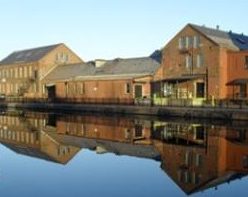
[Ride along Race Street until you are half way between Cabot Street and Sargeant Street. Park to the right and look over the second level canal.]
Clemens Herschel ran the Holyoke Test Flume at this location from 1880 to 1890.
It continued to run after him until 1932. By that year it had run 3176 test runs. It was the best test flume for hydromechanical turbines in North America. When it started testing turbines in 1880, the highest efficiency ever measured was 80.5 percent. By 1932 the highest was 94.57 percent. Herschel invented here:
- waterwheels that could function as their own water meters
- made the Holyoke Test Flume
- made Venturi tube to measure the water flow in pipes
- designed the dam with an ogee shape (having a double continuous S-shaped curve) for most efficient spillway discharge
After Herschel left in 1890, John McCormick continued the work. He not only continued the flume but also upgraded the many turbine features used in hydroelectricity. He invented the turbines called Holyoke, Francis, Hercules, and Samson.
The many small brick buildings immediately above it are the electric power stations of the Holyoke Gas and Electric. At one time they housed the electric stations for various types of electricity. In 1884, Edison DC electricity came to Holyoke to power some nearby streetlights. This was housed in the Cabot Street Mill. This only lasted a year since later in 1884 Schuyler dynamos were placed into use. Holyoke’s Progression
In 1896 Tesla AC electricity came to Holyoke to power locations far from the plant. There were also other dynamos and turbines. This was the most powerful location of Holyoke until the construction of Hadley Falls turbine number 1 in 1953. Nowadays it houses four medium-sized turbines.
To the north notice the Holyoke Water Power Mill which was built in 1880 because the Holyoke Water Power Company wanted to encourage start-up companies within Holyoke. It was successful in that mission having companies like the Massachusetts Screw Company and Holyoke Envelope Mill starting there. It had a massive fire in 1890 that burnt half the structure. It was rebuilt and later sold to Crocker Paper in 1903. By 1970 Riverview Machine Company moved in and stayed into the 1990s. It is now owned by the Fln-Mar Company from rubber businesses owned by Harold Flynn and Jack Marr.
Sanborn map analysis:
